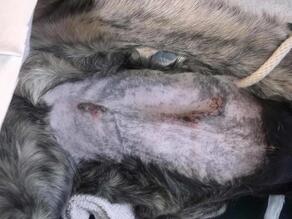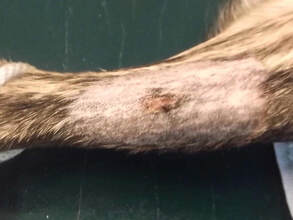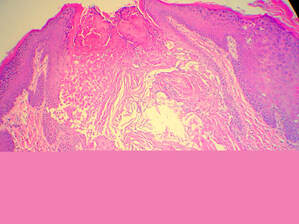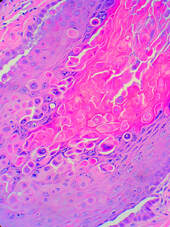Fantastic Case #3
Acantholytic Dyskeratosis (Darier's dz) in a young Mastiff
Acantholytic Dyskeratosis (Darier's dz) in a young Mastiff
This young mastiff developed multiple skin lesions during the first year. At 1 to 2 weeks of age there was a raised lesion noted on the ventral neck with additional lesions then noted along the base of the head, the ear, along the medial thigh, medial tibia and the cheek. The neck lesions were arcuate areas that were raised, as in the first photo. The lesion along the tibia was somewhat linear, as in the second gross photo.
Lesions were biopsied and the primary changes consisted of prominent epidermal thickening, enlargement and some cystic dilation of follicles and prominent dyskeratosis with acantholysis causing some suprabasilar clefting. The lesions were not inflamed (noninflammatory acantholysis).
A group of rare skin conditions with the pattern of acantholysis, dyskeratosis and suprabasilar clefting have been termed acantholytic dyskeratoses. It is quite rare in dogs, but a few different subtypes are recognized in people and some are included under forms of Darier's disease. Given that the breeder was confident there were no congenital lesions at the time of birth in this dog along with the clinical features, this resembles a localized form of Darier's disease that occurs in childhood. Some theorize a post zygotic mutation in the ATP2A2 gene occurs with mosaicism resulting in localized dysfunction of the cellular calcium pump that results in loss of cell to cell adhesion. No other pups in a litter of eight were affected and this case was suspected to be non-hereditary. It's a rare one, but can be considered if you have scattered, early onset similar lesions.
Lesions were biopsied and the primary changes consisted of prominent epidermal thickening, enlargement and some cystic dilation of follicles and prominent dyskeratosis with acantholysis causing some suprabasilar clefting. The lesions were not inflamed (noninflammatory acantholysis).
A group of rare skin conditions with the pattern of acantholysis, dyskeratosis and suprabasilar clefting have been termed acantholytic dyskeratoses. It is quite rare in dogs, but a few different subtypes are recognized in people and some are included under forms of Darier's disease. Given that the breeder was confident there were no congenital lesions at the time of birth in this dog along with the clinical features, this resembles a localized form of Darier's disease that occurs in childhood. Some theorize a post zygotic mutation in the ATP2A2 gene occurs with mosaicism resulting in localized dysfunction of the cellular calcium pump that results in loss of cell to cell adhesion. No other pups in a litter of eight were affected and this case was suspected to be non-hereditary. It's a rare one, but can be considered if you have scattered, early onset similar lesions.





